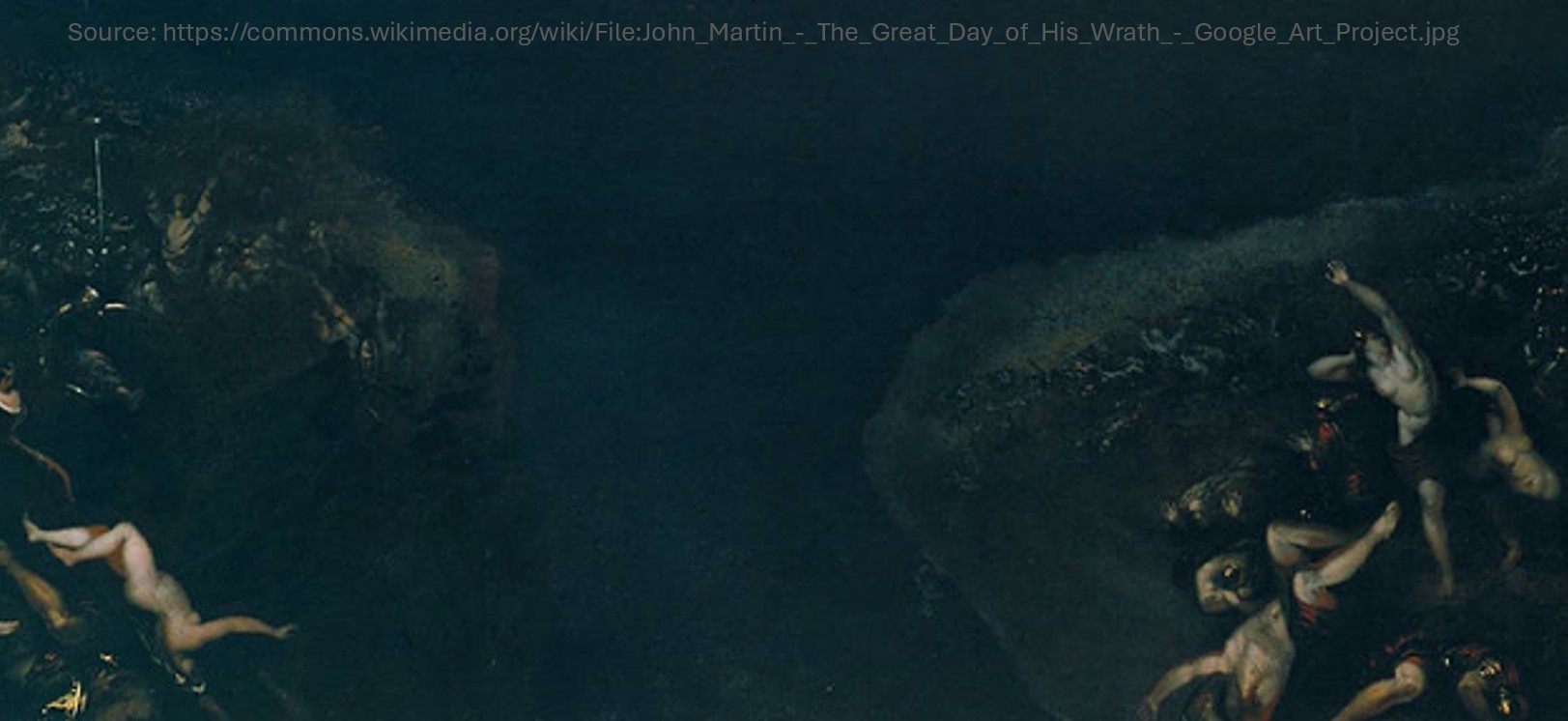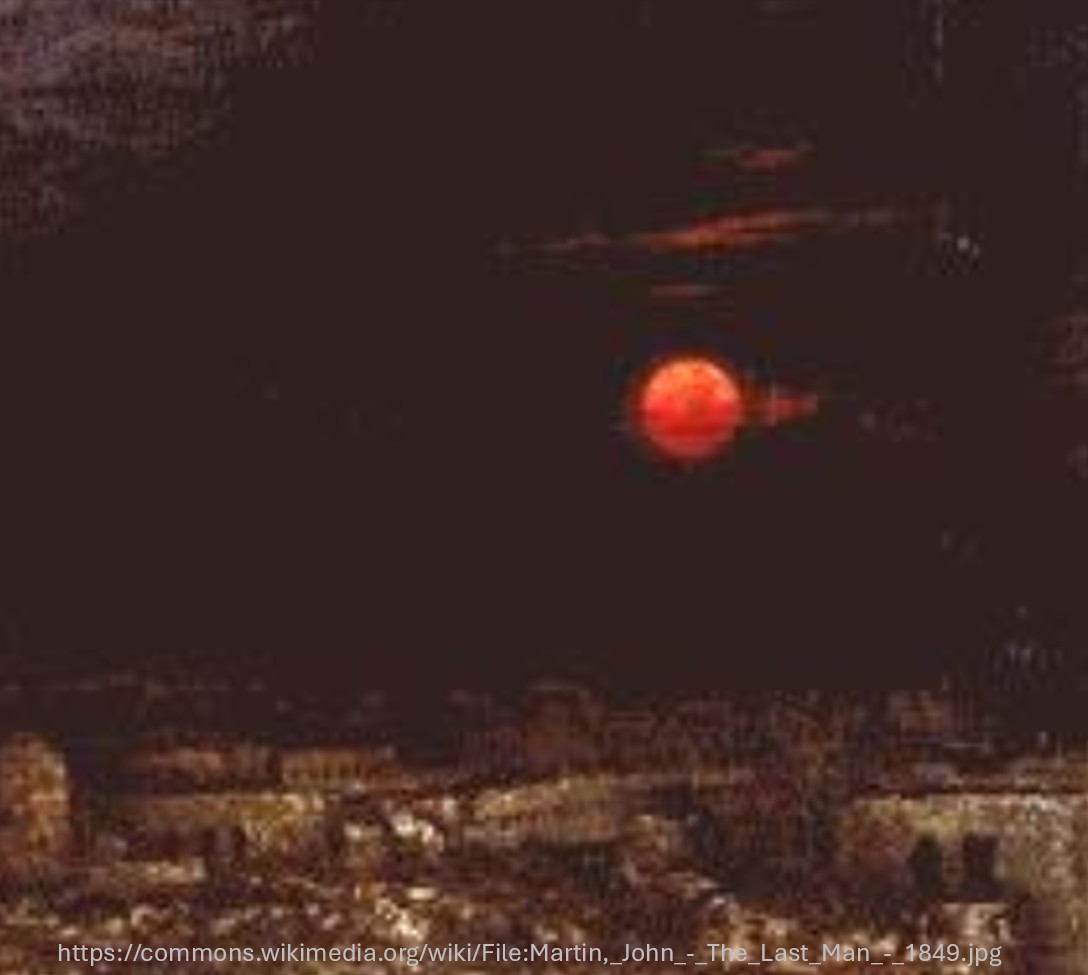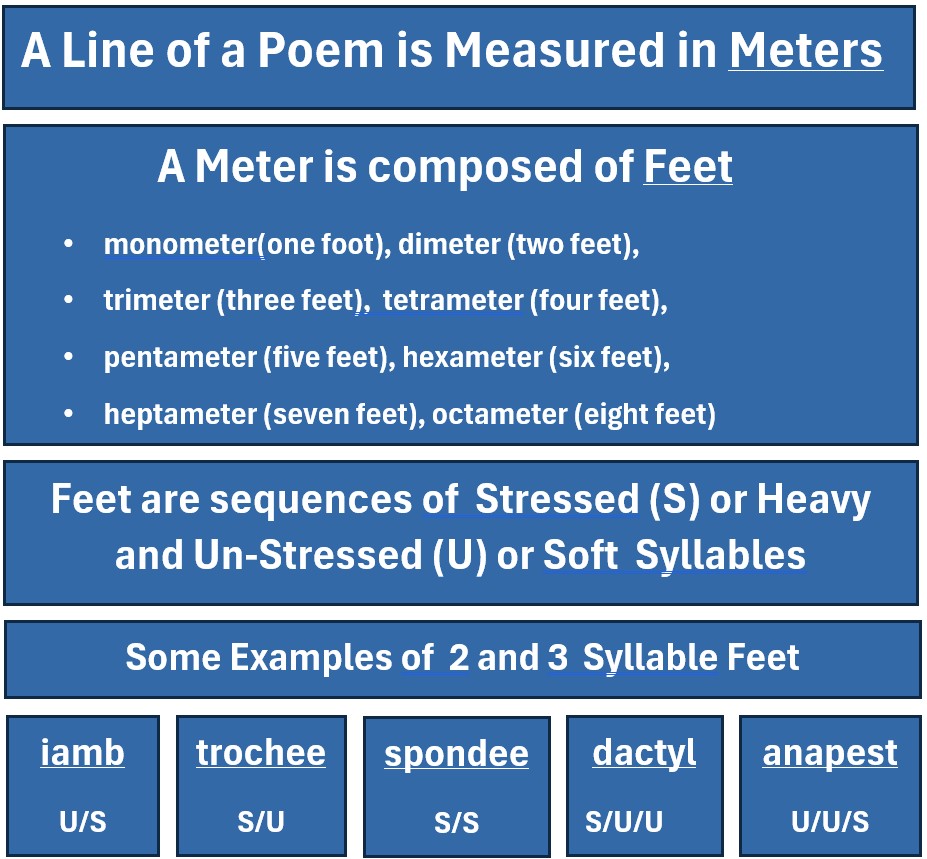Menu (linked Index)
Darkness – by Lord Byron
Last Update: April 20, 2025
- Introduction
- What the Poem is About
- Hear It and Then Read It
- The Poem Darkness (82 lines)
- Poem Structure (Stanza)
- Poem Structure (Meter)
- Poem Structure (Verse)
- Poem Structure (Enjambment)
- Poem Structure (Alliteration)
- Poem Analysis (L1)
- Poem Analysis (L2-5)
- Poem Analysis (L6-9)
- Poem Analysis (L10-32)
- Poem Analysis (L32-37)
- Poem Analysis (L38-46)
- Poem Analysis (L47-54)
- Poem Analysis (L55-69)
- Poem Analysis (L69-82)
- Conclusion
- Appendix 1 – Meter Types
- Appendix 2 – Metric Foot Names
- Appendix 3 – Poetic Devices Reference
Introduction
Recall from my description of George Meredith’s 1883 poem Lucifer in Starlight, that it was a story of the triumph of good over evil.
In this article, we’ll take a 180 degree turn and jump into the dark, desolate, hopeless world of Lord George Gordon Byron’s 1816 poem “Darkness”.
Despite the bleak and hopeless subject matter of “Darkness,” its power lies in Byron’s masterful use of language and punctuation.
I want to examine the poem’s narrative and tone objectively, without succumbing to its negativity.
The primary goal is to dissect Byron’s construction and poetic techniques, hoping to get insights that could help us find or even create a poem with a more positive and purposeful impact.
What Is The Poem About?
Here’s my version of the story Lord Byron tells in his poem “Darkness”.
- He had a dream that the sun burned out.
- Humans built fires to fight the cold and dark.
- War and Famine followd. All living creatures were desperate.
- Even dogs attack their masters except one, which stays by its master till the master dies, and then the dog dies.
- The last two men on earth try to build a fire and seeing the horrible sight of each other, both die.
- The earth is now lifeless and the universe is still and empty.
Well, for the same reason we might love a song that has a beautiful melody but a depressing and negative message or story.
Ok, we need to read the full poem.
Darkness – by Lord Byron (1816)
The form and punctuation of the poem listed below is based on the following source:
- The Prisoner of Chillon and Other Poems by Lord Byron; Houghton Mifflin; 1898
- https://archive.org/details/prisonerchillon00byrogoog/page/n66/mode/2up
Perhaps you can listen to a reading first. You can find many via you tube (try this reading for example).
But then, you MUST read the poem from beginning to end.
Read it all the way through.
And then, read it a few more times.
Darkness – by Lord Byron (1816)
| 1. | I had a dream, which was not all a dream. |
| 2. | The bright sun was extinguish'd, and the stars |
| 3. | Did wander darkling in the eternal space, |
| 4. | Rayless, and pathless, and the icy earth |
| 5. | Swung blind and blackening in the moonless air. |
| 6. | Morn came and went—and came, and brought no day, |
| 7. | And men forgot their passions in the dread |
| 8. | Of this their desolation ; and all hearts |
| 9. | Were chill'd into a selfish prayer for light. |
| 10. | And they did live by watchfires—and the thrones, |
| 11. | The palaces of crowned kings—the huts, |
| 12. | The habitations of all things which dwell, |
| 13. | Were burnt for beacons ; cities were consumed, |
| 14. | And men were gather'd round their blazing homes |
| 15. | To look once more into each other's face : |
| 16. | Happy were those who dwelt within the eye |
| 17. | Of the volcanos and their mountain-torch. |
| 18. | A fearful hope was all the world contain'd ; |
| 19. | Forests were set on fire—but hour by hour |
| 20. | They fell and faded—and the crackling trunks |
| 21. | Extinguish'd with a crash—and all was black. |
| 22. | The brows of men by the despairing light |
| 23. | Wore an unearthly aspect, as by fits |
| 24. | The flashes fell upon them ; some lay down |
| 25. | And hid their eyes and wept ; and some did rest |
| 26. | Their chins upon their clenched hands, and smiled ; |
| 27. | And others hurried to and fro, and fed |
| 28. | Their funeral piles with fuel, and look'd up |
| 29. | With mad disquietude on the dull sky, |
| 30. | The pall of a past world ; and then again |
| 31. | With curses cast them down upon the dust, |
| 32. | And gnash'd their teeth and howl'd. The wild birds shriek'd, |
| 33. | And, terrified, did flutter on the ground, |
| 34. | And flap their useless wings ; the wildest brutes |
| 35. | Came tame and tremulous ; and vipers crawl’d |
| 36. | And twined themselves among the multitude, |
| 37. | Hissing, but stingless—they were slain for food. |
| 38. | And War, which for a moment was no more, |
| 39. | Did glut himself again ; — a meal was bought |
| 40. | With blood, and each sate sullenly apart |
| 41. | Gorging himself in gloom : no love was left ; |
| 42. | All earth was but one thought—and that was death, |
| 43. | Immediate and inglorious ; and the pang |
| 44. | Of famine fed upon all entrails—men |
| 45. | Died, and their bones were tombless as their flesh. |
| 46. | The meagre by the meagre were devour'd : |
| 47. | Even dogs assail'd their masters, all save one, |
| 48. | And he was faithful to a corse, and kept |
| 49. | The birds and beasts and famish'd men at bay, |
| 50. | Till hunger clung them, or the dropping dead |
| 51. | Lured their lank jaws ; himself sought out no food, |
| 52. | But with a piteous and perpetual moan, |
| 53. | And a quick desolate cry, licking the hand |
| 54. | Which answer'd not with a caress—he died. |
| 55. | The crowd was famish'd by degrees ; but two |
| 56. | Of an enormous city did survive, |
| 57. | And they were enemies : they met beside |
| 58. | The dying embers of an altar-place |
| 59. | Where had been heap'd a mass of holy things |
| 60. | For an unholy usage ; they raked up, |
| 61. | And shivering scraped with their cold skeleton hands |
| 62. | The feeble ashes, and their feeble breath |
| 63. | Blew for a little life, and made a flame |
| 64. | Which was a mockery ; then they lifted up |
| 65. | Their eyes as it grew lighter, and beheld |
| 66. | Each other's aspects—saw, and shriek'd, and died— |
| 67. | Even of their mutual hideousness they died, |
| 68. | Unknowing who he was upon whose brow |
| 69. | Famine had written Fiend. The world was void, |
| 70. | The populous and the powerful was a lump, |
| 71. | Seasonless, herbless, treeless, manless, lifeless— |
| 72. | A lump of death—a chaos of hard clay. |
| 73. | The rivers, lakes and ocean all stood still, |
| 74. | And nothing stirr'd within their silent depths ; |
| 75. | Ships sailorless lay rotting on the sea, |
| 76. | And their masts fell down piecemeal ; as they dropp'd, |
| 77. | They slept on the abyss without a surge— |
| 78. | The waves were dead ; the tides were in their grave, |
| 79. | The moon, their mistress, had expired before ; |
| 80. | The winds were wither'd in the stagnant air, |
| 81. | And the clouds perish'd ; Darkness had no need |
| 82. | Of aid from them—She was the Universe. |
“Darkness” is a Single Stanza 82 Line Poem
A Stanza (“stopping place” in Italian) is “A grouping of lines separated from others in a poem“. They are the paragraphs of a poem.
I see Byron’s Darkness as a Single – Stanza – 82 – Line – continuous – stream – of – consciousness poem.
It only has 12 sentences.
I feel the poem was designed to be read with little hesitation or pause; with dashes, colons, semicolons, and commas serving as guideposts.
“Darkness” is a Metrical Mixture
This poem does not have metrical consistency.
- A meter (metre) is the “The rhythmical pattern of stressed and unstressed syllables in verse“.
- A meter is composed of feet. The foot is the unit of measurement of a meter (it usually contains one stressed syllable and at least one unstressed syllable).
- The Iamb is the most common type of foot. It consists of two syllables arranged in a sequence of Unstressed/Stressed or U/S.
- An Iambic Pentameter line in poetry is 10 syllables long, arranged in 5 sequences of Unstressed/Stressed vowels (i.e. say “da-DUM” 5 times)
- There are many other possible syllabic sequences in Poetry: See Appendix 1 and 2 for examples.
In Darkness there are few Iambic Pentameter Lines like lines 1 , 6, and 78:
- (1) I had |a dream|, which was| not all| a dream.|
- (6) |Morn came| and went|—and came|, and brought| no day,
- (78) The waves | were dead;| the tides| were in| their grave,|
In fact, this poem has fluctuating rhythmic patterns.
It seems to shift as the poem unfurls itself.
This lack of rhythmic consistency has a great effect on this reader:
- The poem pulsates at different speeds and
- renders me eager to continue reading but also
- uncomfortable and unsettled.
“Darkness” is Free/Blank Verse
- Free Verse consists of “Rhythmical but non-metrical, non-rhyming lines” while
- Blank Verse is “Unrhyming iambic pentameter, also called heroic verse” (10 syllable lines).
The poem “Darkness” is Free/Blank Verse; being some concoction of the two.
- “Darkness” has some Iambic Pentameter lines or lines that at least hint at that structure, but most of it does not fit the Iambic rhythm.
- There are few rhymes:
- (34) And flap their useless wings ; the wildest brutes
(35) Came tame and tremulous ; and vipers crawl’d
(36) And twined themselves among the multitude,
(37) Hissing, but stingless—they were slain for food. - (39)Did glut himself again ; — a meal was bought
(40)With blood, and each sate sullenly apart
(41)Gorging himself in gloom : no love was left ;
(42)All earth was but one thought—and that was death,
- (34) And flap their useless wings ; the wildest brutes
- 68 of the lines have 10 syllables,
- 2 lines have nine syllables,
- 7 have 11 and
- 5 have 12
“Darkness” Enjambs
Enjambment , “The running-over of a sentence or phrase from one poetic line to the next, without terminal punctuation” is used throughout “Darkness”.
It comes from the French word enjamber which means to step over.
This 82 lined poem contains only 12 sentences with 35 of the lines enjambed with no-end punctuation.
I think the overall effect of these enjambed lines is to speed up the pace of the poem and its depiction of destruction and despair.
If you look at the poem overall (see picture below – green highlighted lines are enjambed), notice that there is only one enjambment (line 81) in the last 14 lines.

With the help of periods, colons, commas, and dashes, the pace towards the end of the poem has shifted to a slower speed, leading to the end of the poem where darkness envelopes the universe.
“Darkness” Alliterates and Consonates
Here a few more poetic Devices: Assonance, Alliteration, and Consonance.
“Darkness” employs them all, especially Alliteration.
Assonance is the repetition of vowel sounds anywhere in a line.
Alliteration is the repetition of consonants (typically) at the beginning of words.
Consonance is is the repetition of consonants anywhere in a line.
All of these add rhythm to the poem and help to emphasize the event at hand.
I will make reference to them in my line-by-line analysis of the poem which starts in the next section.
A Dream, but Not All a Dream (L1)
(1) I had a dream , which was not all a dream.
Byron wrote this in 1816 in Geneva. The weather was rainy , overcast , and cold.
This mostly was due to the volcanic winter event caused by the massive 1815 eruption of Mount Tambora in April in modern-day Indonesia.
1816 was known as the “Year Without a Summer.”
So Byron was maybe saying, “hey this is a vision mostly imagined but the beginnings of which are being witnessed”.
This is one of the few lines in the poem that has Iambic Pentameter meter structure (scansion).
- 10 syllables
- {U/S}{U/S}{U/S}{U/S}{U/S}
- Iambic Pentameter
- 5 Sets of Iambic US/S syllable sequences
- U = Un-Stressed syllable
- S = Stressed syllable
Death of Light (L2-5)
The bleak tone is established immediately in the beginning lines. (lines 2-5 which comprise 1 sentence).
With finality, humanity has lost celestial light.
This is gorgeous and bleak prose.
Scansion (Meter Identification)
I used Appendix 2 and made a stab at identifying the metrical feet of these lines to see how many Iambic Pentameters there were.
In the lines below (and in later sections), I’ve underlined consonance elements.
- There are none according to my scansion
(2) The bright sun was extinguish‘d, and the stars
- 10 Syllables: {U/S/S}{U/S/S/S}{U/U/S}
- Metrical Feet Types: Bachius, 1st Epitrite, Anapest
(3) Did wander darkling in the eternal space,
- Did wander darkling has stunning consonance.
- 11 Syllables: {U/S/U}{S/U}{U/U}{U/S/U/S}
- Metrical Feet Type: Amphibrach, Trochee, Pyrrhic, Diamb
(4) Rayless, and pathless, and the icy earth
- 10 Syllables: {S/U}{U/S/U}{U}{U/S/U/S}
- Metrical Feet Type: Trochee, Amphibrach, Monosyllable, Diamb
(5) Swung blind and blackening in the moonless air.
- Beautiful personification and alliteration in “the icy earth Swung blind and blackening”!
- 11 Syllables:{S/S}{U/S/U/U}{U/U}{S/U/S}
- Metrical Feet Type: Spondee, Secundus Paeon, Pyrrhus, Cretic
Repeating consonant sounds substitute for the lack of meter consistency. They make the words more emphatic and memorable.
I’m not going to do a scansion for other lines in the poem, but if you try to do it , you’ll see that few lines have a consistent Iambic Pentameter pattern.
Endless Night (L6-9)
In a sentence (lines 6 – 9) , the tone is set for the poem.
The morning is personified as coming and going but without any light.
Line 6 is also in Iambic Pentameter form.
Man becomes maniacally focused on survival.
(6) Morn came and went—and came, and brought no day,
(7) And men forgot their passions in the dread
(8) Of this their desolation ; and all hearts
(9) Were chill’d into a selfish prayer for light.
Do you feel the rhythmic effect of the alliteration “in the dread of this their desolation“?
Fire and Light (L10-32)
Humans Burn Everything to Have Light and Warmth
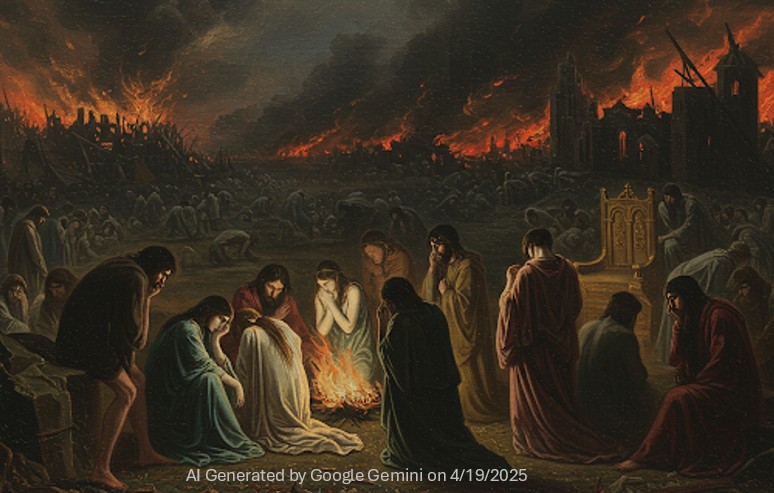
(10) And they did live by watchfires—and the thrones,
(11) The palaces of crowned kings—the huts,
(12) The habitations of all things which dwell,
(13) Were burnt for beacons ; cities were consumed,
(14) And men were gather’d round their blazing homes
(15) To look once more into each other’s face :
(16) Happy were those who dwelt within the eye
(17) Of the volcanos and their mountain-torch.
(18) A fearful hope was all the world contain’d ;
(19) Forests were set on fire—but hour by hour
(20) They fell and faded—and the crackling trunks
(21) Extinguish’d with a crash—and all was black.
Observe
- the breathtaking two sentences comprising 12 lines.
- the rich consonance usage in the red highlighted text.
- the vivid imagery and especially the Onomatopoeia-ic “crackling trunks”
Humans go Mad as the Light Diminishes
Desperate and hopeless, man descends into madness.
(22) The brows of men by the despairing light
(23) Wore an unearthly aspect, as by fits
(24) The flashes fell upon them ; some lay down
(25) And hid their eyes and wept ; and some did rest
(26) Their chins upon their clenched hands, and smiled ;
(27) And others hurried to and fro, and fed
(28) Their funeral piles with fuel, and look’d up
(29) With mad disquietude on the dull sky,
(30) The pall of a past world ; and then again
(31) With curses cast them down upon the dust, {as in cast themselves down}
(32) And gnash’d their teeth and howl’d. The wild birds shriek’d,
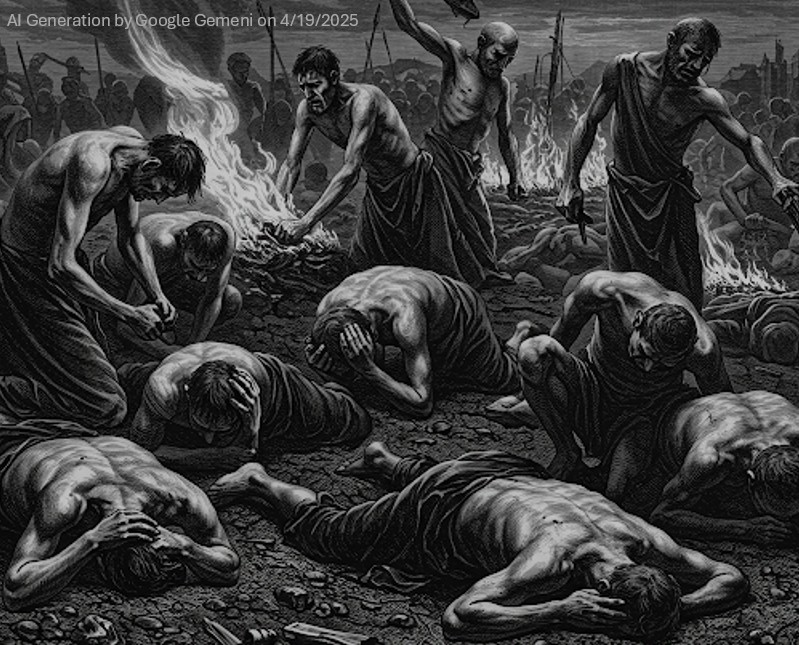
In just one sentence, these 11 lines evoke haunting and startling images and sounds.
For example,
- line 22: The image of a distorted and disfigured and tortured look of the “brows of men”.
- lines 22-24, where tortured faces flicker in and out of darkness.
- lines 28-30, where bewildered and in great unease, humans look up at a sky described metaphorically as a “pall of a past world” (i.e. a cloth draped on the coffin of a world that no longer exists).
- the alliteration of line 29 and the beautiful use of the word disquietude (uneasy state of mind).
Chaos And Death (L32-37)
Animals succumb as well.
(32) And gnash’d their teeth and howl’d. The wild birds shriek’d,
(33) And, terrified, did flutter on the ground,
(34) And flap their useless wings ; the wildest brutes
(35) Came tame and tremulous ; and vipers crawl’d
(36) And twined themselves among the multitude,
(37) Hissing, but stingless—they were slain for food.
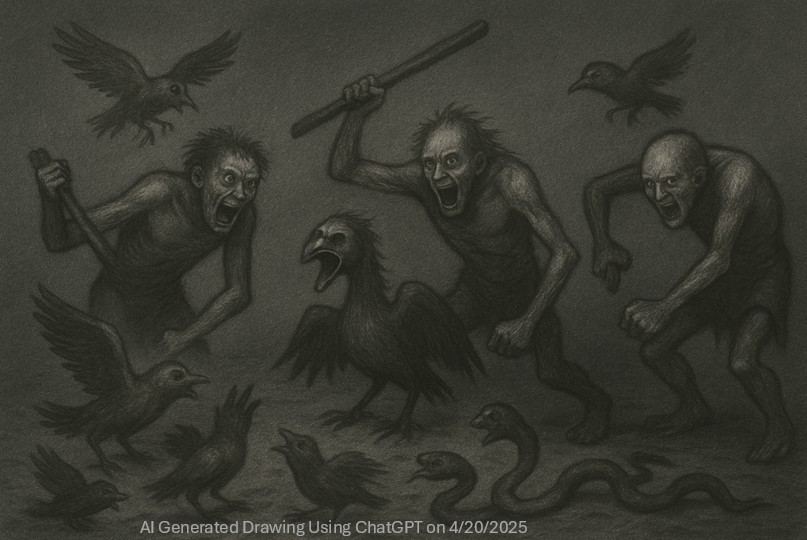
We experience evocative sounds and images via
- Consonance
- Assonance in line 35 (same vowel sound)
- Rhymes: brutes, multitude, food
- Onomatopoeia: “shriek’d, flutter, flap, hissing”
War and Famine (L38-46)
The descent continues into war and famine and cannibalism.
(38) And War, which for a moment was no more,
(39) Did glut himself again ; — a meal was bought
(40) With blood, and each sate sullenly apart
(41) Gorging himself in gloom : no love was left ;
(42) All earth was but one thought—and that was death,
(43) Immediate and inglorious ; and the pang
(44) Of famine fed upon all entrails—men
(45) Died, and their bones were tombless as their flesh.
(46) The meagre by the meagre were devour’d :
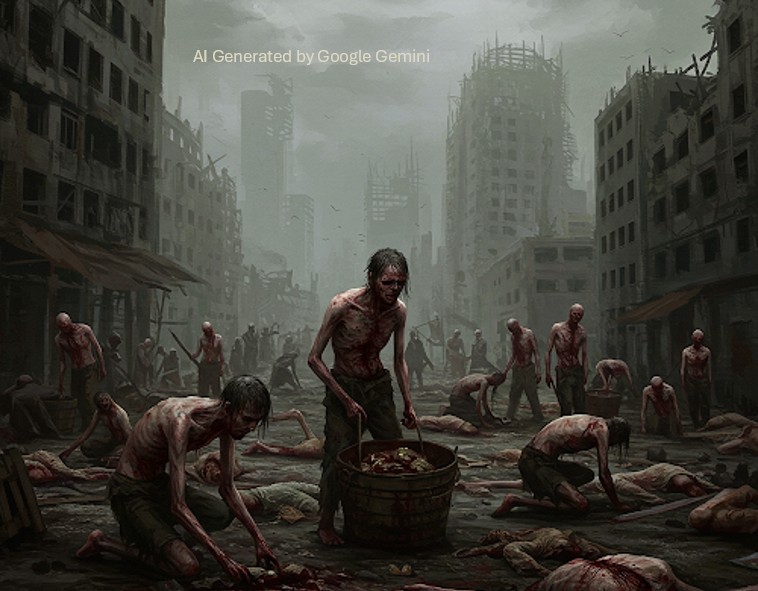
These lines are briefly restrained by a semi colon and colon.
I’ve highlighted in red the
- the luscious personification “War…Did glut himself” and
- the structurally binding consonance and alliteration of
- “sate sullenly” (i.e. eat)
- “Gorging…in gloom”
- “no love was left”
- “Immediate and inglorious”
- “famine fed”
- “bones were tombless”
Even “dogs assail’d their master, all save one” (L47-54)
“Darkness” presents humans as wretched, hopeless, irredeemable, and non heroic.
For the first and last time in the poem, Lord Byron shows his sole and fleeting sympathy for a dog, who remains faithful to his now dead master.
The dog keeps starving men and animals at bay till hunger kills them or they are diverted to the other dead.

But eventually, inevitable death claims the dog as well.
(47) Even dogs assail’d their masters, all save one,
(48) And he was faithful to a corse, and kept {corse meaning corpse}
(49) The birds and beasts and famish’d men at bay,
(50) Till hunger clung them, or the dropping dead
(51) Lured their lank {gaunt, thin} jaws ; himself sought out no food,
(52) But with a piteous and perpetual moan,
(53) And a quick desolate cry, licking the hand
(54) Which answer’d not with a caress—he died.
See how the alliterative
- “dropping dead”
- “lured by their lank jaws”
- “piteous and perpetual”
maintain the rhythm.
The Last Two Die (L55-69)
Hurtling towards extinction, Lord Byron’s “Darkness” destroys the last two humans.
As they feebly attempt to keep the last man made flames burning, they catch a glimpse of themselves.
Upon seeing each other’s maddened and emaciated forms, they too die, not recognizing any humanity in each other’s appearance.
(55) The crowd was famish’d by degrees ; but two
(56) Of an enormous city did survive,
(57) And they were enemies : they met beside
(58) The dying embers of an altar-place
(59) Where had been heap’d a mass of holy things
(60) For an unholy usage ; they raked up,
(61) And shivering scraped with their cold skeleton hands
(62) The feeble ashes, and their feeble breath
(63) Blew for a little life, and made a flame
(64) Which was a mockery ; then they lifted up
(65) Their eyes as it grew lighter, and beheld
(66) Each other’s aspects—saw, and shriek’d, and died—
(67) Even of their mutual hideousness they died,
(68) Unknowing who he was upon whose brow
(69) Famine had written Fiend. The world was void,

Lines 67 – 69 evoke an image of humans stripped of their human-ness.
In these 15 lines we experience one cascading, plummeting sentence depicting the demise of the last humans (sorry, I had to use a little alliteration in there).
Universal Darkness (L69-82)
- Stillness spreads.
- Ships at the bottom of seas are motionless; the water still.
- The Universe becomes Dark.
(69) Famine had written Fiend. The world was void,
(70) The populous and the powerful was a lump,
(71) Seasonless, herbless, treeless, manless, lifeless—
(72) A lump of death—a chaos of hard clay.
(73) The rivers, lakes and ocean all stood still,
(74) And nothing stirr’d within their silent depths ;
(75) Ships sailorless lay rotting on the sea,
(76) And their masts fell down piecemeal ; as they dropp’d,
(77) They slept on the abyss without a surge—
(78) The waves were dead ; the tides were in their grave, 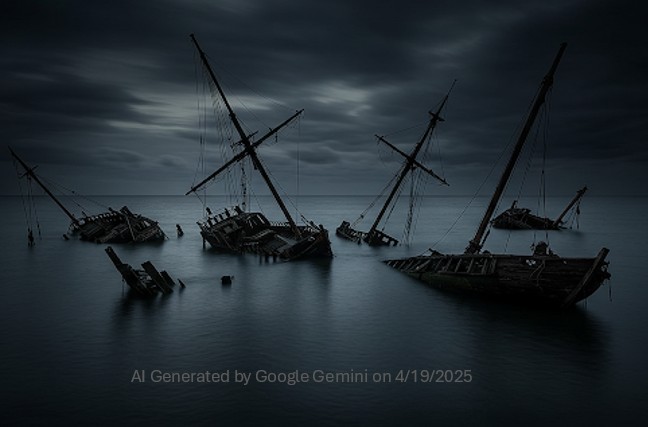
(79) The moon, their mistress, had expired before ;
(80) The winds were wither’d in the stagnant air,
(81) And the clouds perish’d ; Darkness had no need
(82) Of aid from them—She was the Universe.

The fast harrowing pace now slows.
The abundance of punctuation in every line decelerates the rhythm.
Lines with consonance set the mood with prevailing soft s sounds; suggesting slowing, softening, and sleep. (sorry , I did it again).
Alliteration once again binds the lines and gives them structure and rhythm:
- The populous and the powerful
- The waves were dead
- The winds were wither’d
Metaphor and personification allows the horrible to be evoked clearly and personally.
- A lump of clay is used as a metaphor to describe the dead.
- Ships are personified as sleeping at the bottom of the seas and
- the moon is personified as the mistress of the tides.
Conclusion
Wow.
You might feel like you’ve simultaneously been
- punched in the gut while
- being treated to extraordinarily exquisite, lyrical, and evocative prose.
What a stark contrast between the beautiful language and the terrible imagery of the poem!
What do I want to take away from it?
I prefer not to focus on the dismal message and intended meaning of the poem as it seems to reflect the depressed state of mind and body that Byron was in at the time of its writing.
On a technical level, I think I learned a few useful things about poetic devices.
Most importantly, the poem demonstrates to me the immense communicative power of words; a power that I think should be harnessed for positive and inspirational messages.
Discover Lord Byron
Byron’s life was artistic, creative, and sensational.
It was also controversial, tumultuous, and brief (36 years; 1788–1824); kind of like his poem “Darkness”.
He was (explore more information via the embedded links)
- a great poet,
- disabled,
- the international celebrity rock star prototype,
- charismatic,
- a romantic rake and libertine,
- “mad, bad, and dangerous to know”,
- the model for Dracula,
- one of the inspirations for the novel Frankenstein, (see this link also)
- a martyr for Greek Freedom,
- dead at 36!
- The Prisoner of Chillon and Other Poems by Lord Byron; Houghton Mifflin; 1898
- Lord Byron’s Darkest Summer by Nina Martyris ; April 28, 2016
- The crazy true story of Lord Byron
- (Video Podcast) Lord Byron: Mad, Bad & Dangerous To Know | Parts 1,2,3,4
- (Master’s Thesis) Lord Byron’s “Darkness”: Analysis and Interpretation (David M. Mazurowski); 1977
| Sressed (S) and Unstressed(U) Syllable Combinations | Name of Foot |
|---|---|
| US(12x) | Alexandrine |
| USU | Amphibrach |
| SUS | Amphimacer |
| UUS | Anapaest or Anapest; uus |
| SSU | Antibacchius |
| UUS | Antidactylus |
| USSU | Antispast |
| Google it | Asclepiad |
| USS | Bacchius; uss |
| U or S | Bob |
| U | Brach |
| SU | Choree or Choreus |
| SUUS | Choriamb or Choriambus |
| SUS | Cretic |
| SUU | Dactyl |
| USUS | Diamb or Diiamb |
| UU | Dibrach |
| SUSU | Dichoree or Dichoreus |
| SS | Dimacer |
| SSSS | Dispondee |
| SUSU | Ditrochee |
| USSUS | Dochmius |
| UUSS | Double Iamb |
| SSUU | Double Trochee |
| USSS | First Epitrite;usss |
| SSSU | Fourth Epitrite |
| Google it | Hemiepes |
| US | Iamb or Iambus |
| S | Macer |
| SSUU | Major Ionic |
| UUSS | Minor Ionic |
| SSS | Molossus |
| U or S | Monosyllabic |
| SUS | Paeon Diagyios |
| SUUU | Primus Paeon |
| UUUU | Proceleus maticus or Proceleusmatic |
| UU | Pyrrhus; Pyrrhic |
| UUUS | Quartus Paeon |
| Google it | Sapphic |
| SUSS | Second Epitrite |
| USUU | Secundus Paeon |
| SS | Spondee |
| UUSU | Tertius Paeon |
| UUUU | Tetrabrach |
| SSUS | Third Epitrite |
| UUU | Tribrach |
| SU | Trochee |
Appendix 3 – Poetic Devices References
Definitions for the poetical terms discussed in this article come from the following sources:
- RPO: Representative Poetry Online https://rpo.library.utoronto.ca/glossary
- Poetry Foundation https://www.poetryfoundation.org/education/glossary/stanza
- A Glossary of Literary Terms, 11th Ed, by Abrams and Harpham
Disclaimer: The content of this article is intended for general informational and recreational purposes only and is not a substitute for professional “advice”. We are not responsible for your decisions and actions. Refer to our Disclaimer Page.
